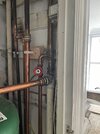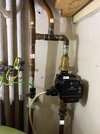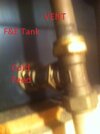I have a open vented heat only boiler and a vented indirect cylinder
The fand e tank has the three connections you mentioned.
I would expect there to be discharge from the vent pipes but I would never expect water to come back down from the discharge pipes. They are higher than the top of the fande cylinder and not touching
It definitely seems like when mains cold and hot is mixed the brown water comes down and is aggitated
Before I change the tap I want to understand how this is possible and where the brown water is coming from
The fand e tank has the three connections you mentioned.
I would expect there to be discharge from the vent pipes but I would never expect water to come back down from the discharge pipes. They are higher than the top of the fande cylinder and not touching
It definitely seems like when mains cold and hot is mixed the brown water comes down and is aggitated
Before I change the tap I want to understand how this is possible and where the brown water is coming from






